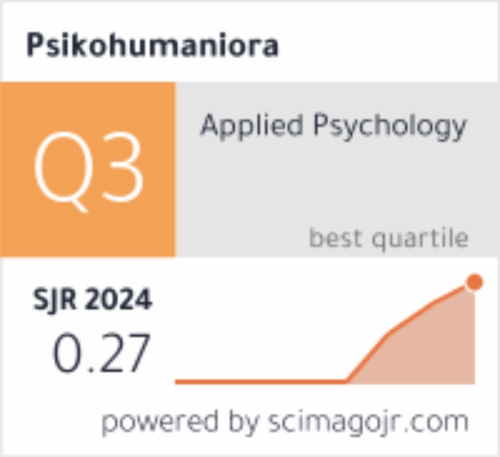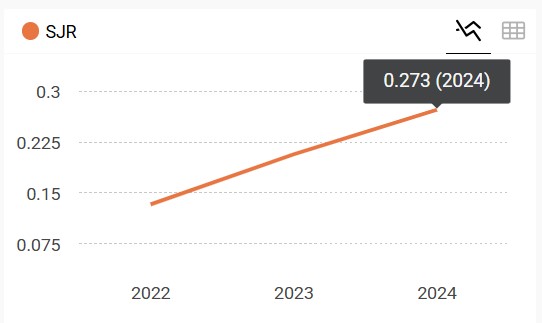Exploring gender differences in the vulnerability towards drug abuse among adolescents in Malaysia
DOI:
https://doi.org/10.21580/pjpp.v6i1.6679Keywords:
gender, vulnerability, drug abuseAbstract
Protective and risk factors are important issues to consider to reduce the vulnerability of adolescents to drug abuse. This study aims to determine the vulnerability to drug abuse in terms of gender differences in high-risk areas, based on statistics/data from the National Anti Narcotics Agency of Malaysia, namely in Sabak Bernam, Dungun, Johor Bahru, and Kuala Kedah. A survey method was employed, with 213 adolescents (52.1% male, 47.9% female) who met the inclusion criteria completing the questionnaire. The questionnaire consisted of five aspects, namely demographic profile, interpersonal conflict, negative emotions, social support, and mental health. Data analysis was conducted using descriptive and inferential statistics. The results of the analysis show that there was no significant difference in aspects of interpersonal conflict (t=-0.556, p > .05), negative emotions (t=0.131, p>.05), or mental health by gender (t=-0.898, p > .05). However, there was a significant difference in the aspect of social support (t=-2.046, p <.05), with female subjects (37.13) showing a higher mean score than males (34.83). The findings of the study indicate that it is very important to understand the relevant factors so that drug abuse can be identified and prevented early on.
Downloads
References
Anderberg, M., & Dahlberg, M. (2018). Gender differences among adolescents with substance abuse problems at Maria clinics in Sweden. Nordic Studies on Alcohol and Drugs, 35(1), 24–38. https://doi.org/10.1177/1455072517751263
Association, A. P. (2013). Diagnostic and statistical manual of mental disorders (DSM-5®). American Psychiatric Pub.
Becker, J. B., & Koob, G. F. (2016). Sex differences in animal models: Focus on addiction. Pharmacological Reviews, 68(2), 242–263. https://doi.org/10.1124/pr.115.011163
Becker, J. B., McClellan, M. L., & Reed, B. G. (2017). Sex differences, gender and addiction. Journal of Neuroscience Research, 95(1–2), 136–147. https://doi.org/10.1002/jnr.23963
Becker, J. B., McClellan, M., & Reed, B. G. (2016). Sociocultural context for sex differences in addiction. Addiction Biology, 21(5), 1052–1059. https://doi.org/10.1111/adb.12383
Becker, J. B., Perry, A. N., & Westenbroek, C. (2012). Sex differences in the neural mechanisms mediating addiction: a new synthesis and hypothesis. Biology of Sex Differences, 3(1), 14. https://doi.org/10.1186/2042-6410-3-14
Bliton, C. F., Wolford-Clevenger, C., Zapor, H., Elmquist, J., Brem, M. J., Shorey, R. C., & Stuart, G. L. (2016). Emotion dysregulation, gender, and intimate partner violence perpetration: An exploratory study in college students. Journal of Family Violence, 31(3), 371–377. https://doi.org/10.1007/s10896-015-9772-0
Bobzean, S. A. M., DeNobrega, A. K., & Perrotti, L. I. (2014). Sex differences in the neurobiology of drug addiction. Experimental Neurology, 259, 64–74. https://doi.org/10.1016/j.expneurol.2014.01.022
Camara, M., Bacigalupe, G., & Padilla, P. (2017). The role of social support in adolescents: are you helping me or stressing me out? International Journal of Adolescence and Youth, 22(2), 123–136. https://doi.org/10.1080/02673843.2013.875480
Carroll, M. E., Collins, M., Kohl, E. A., Johnson, S., & Dougen, B. (2016). Sex and menstrual cycle effects on chronic oral cocaine self-administration in rhesus monkeys: Effects of a non-drug alternative reward. Psychopharmacology, 233(15–16), 2973–2984. https://doi.org/10.1007/s00213-016-4343-5
Gubbels, J., van der Put, C. E., & Assink, M. (2019). Risk factors for school absenteeism and dropout: A meta-analytic review. Journal of Youth and Adolescence, 48(9), 1637–1667. https://doi.org/10.1007/s10964-019-01072-5
Håkansson, A., & Jesionowska, V. (2018). Associations between substance use and type of crime in prisoners with substance use problems – a focus on violence and fatal violence. Substance Abuse and Rehabilitation, Volume 9, 1–9. https://doi.org/10.2147/SAR.S143251
Heinrich, A., Müller, K. U., Banaschewski, T., Barker, G. J., Bokde, A. L. W., Bromberg, U., Büchel, C., Conrod, P., Fauth-Bühler, M., Papadopoulos, D., Gallinat, J., Garavan, H., Gowland, P., Heinz, A., Ittermann, B., Mann, K., Martinot, J.-L., Paus, T., Pausova, Z., … Nees, F. (2016). Prediction of alcohol drinking in adolescents: Personality-traits, behavior, brain responses, and genetic variations in the context of reward sensitivity. Biological Psychology, 118, 79–87. https://doi.org/10.1016/j.biopsycho.2016.05.002
Johnston, L. D., O’Malley, P. M., Miech, R. A., Bachman, J. G., & Schulenberg, J. E. (2015). Monitoring the future national survey results on drug use: 1975–2014: Overview, key findings on adolescent drug use. Institute for Social Research, The University of Michigan.
Jordan, C. J., & Andersen, S. L. (2017). Sensitive periods of substance abuse: Early risk for the transition to dependence. Developmental Cognitive Neuroscience, 25, 29–44. https://doi.org/10.1016/j.dcn.2016.10.004
Kachadourian, L. K., Pilver, C. E., & Potenza, M. N. (2014). Trauma, PTSD, and binge and hazardous drinking among women and men: Findings from a national study. Journal of Psychiatric Research, 55, 35–43. https://doi.org/10.1016/j.jpsychires.2014.04.018
Khazaee-Pool, M., Pashaei, T., Nouri, R., Taymoori, P., & Ponnet, K. (2019). Understanding the relapse process: exploring Iranian women’s substance use experiences. Substance Abuse Treatment, Prevention, and Policy, 14(1), 27. https://doi.org/10.1186/s13011-019-0216-3
Lieberman, R., Armeli, S., Scott, D. M., Kranzler, H. R., Tennen, H., & Covault, J. (2016). FKBP5 genotype interacts with early life trauma to predict heavy drinking in college students. American Journal of Medical Genetics Part B: Neuropsychiatric Genetics, 171(6), 879–887. https://doi.org/10.1002/ajmg.b.32460
Macleod, J., Hickman, M., Jones, H. E., Copeland, L., McKenzie, J., De Angelis, D., Kimber, J., & Robertson, J. R. (2013). Early life influences on the risk of injecting drug use: Case control study based on the Edinburgh Addiction Cohort. Addiction, 108(4), 743–750. https://doi.org/10.1111/add.12056
Mandavia, A., Robinson, G. G. N., Bradley, B., Ressler, K. J., & Powers, A. (2016). Exposure to childhood abuse and later substance use: Indirect effects of emotion dysregulation and exposure to trauma. Journal of Traumatic Stress, 29(5), 422–429. https://doi.org/10.1002/jts.22131
N.A.D.A. (2018). Maklumat dadah agensi anti dadah kebangsaan, kementerian dalam negeri. National Anti-Drugs Agency Drug Information, Ministry of Home Affairs.
N.I.D.A. (2014). Principles of substance abuse prevention for early childhood. National Institute on Drug Abuse.
Ólafsdóttir, J., Hrafnsdóttir, S., & Orjasniemi, T. (2018). Depression, anxiety, and stress from substance-use disorder among family members in Iceland. Nordic Studies on Alcohol and Drugs, 35(3), 165–178. https://doi.org/10.1177/1455072518766129
Otiniano Verissimo, A. D., Gee, G. C., Ford, C. L., & Iguchi, M. Y. (2014). Racial discrimination, gender discrimination, and substance abuse among Latina/os nationwide. Cultural Diversity and Ethnic Minority Psychology, 20(1), 43–51. https://doi.org/10.1037/a0034674
Perry, A. N., Westenbroek, C., & Becker, J. B. (2013). The development of a preference for cocaine over food identifies individual rats with addiction-like behaviors. PLoS ONE, 8(11), e79465. https://doi.org/10.1371/journal.pone.0079465
Rapier, R., McKernan, S., & Stauffer, C. S. (2019). An inverse relationship between perceived social support and substance use frequency in socially stigmatized populations. Addictive Behaviors Reports, 10, 100188. https://doi.org/10.1016/j.abrep.2019.100188
Razali, M. M., & Kliewer, W. (2015). Risk and protective factors for recreational and hard drug use among Malaysian adolescents and young adults. Addictive Behaviors, 50, 149–156. https://doi.org/10.1016/j.addbeh.2015.06.022
Rickwood, D., Deane, F. P., Wilson, C. J., & Ciarrochi, J. (2005). Young people’s help-seeking for mental health problems. Australian E-Journal for the Advancement of Mental Health, 4(3), 218–251. https://doi.org/10.5172/jamh.4.3.218
Roblyer, M. I. Z., Betancourth, S., & Grzywacz, J. G. (2015). Risk and protective factors for lifetime marijuana use among Colombian emergent adults attending college. ISSBD Bulletin, 2015(1), 5.
Rodzlan Hasani, W. S., Miaw Yn, J. L., Saminathan, T. A., Robert Lourdes, T. G., Ramly, R., Abd Hamid, H. A., Ismail, H., Abd Majid, N. L., Mat Rifin, H., Awaluddin, S. M., & Mohd Yusoff, M. F. (2019). Risk factors for illicit drug use among Malaysian male adolescents. Asia Pacific Journal of Public Health, 31(8_suppl), 48S-56S. https://doi.org/10.1177/1010539519865053
Schwinn, T. M., Schinke, S. P., Hopkins, J., & Thom, B. (2016). Risk and protective factors associated with adolescent girls’ substance use: Data from a nationwide Facebook sample. Substance Abuse, 37(4), 564–570. https://doi.org/10.1080/08897077.2016.1154495
Silva, S. A., Silva, S. U., Ronca, D. B., Gonçalves, V. S. S., Dutra, E. S., & Carvalho, K. M. B. (2020). Common mental disorders prevalence in adolescents: A systematic review and meta-analyses. PLOS ONE, 15(4), e0232007. https://doi.org/10.1371/journal.pone.0232007
Smith, N. Z., Vasquez, P. J., Emelogu, N. A., Hayes, A. E., Engebretson, J., & Nash, A. J. (2020). The good, the bad, and Recovery: Adolescents describe the advantages and disadvantages of alternative peer groups. Substance Abuse: Research and Treatment, 14, 117822182090935. https://doi.org/10.1177/1178221820909354
Substance Abuse and Mental Health Services Administration. (2014).
Sulaiman, W. S. W., Kadir, N. B. A., Halim, F. W., Omar, F., Latiff, R. A., & Sulaiman, W. S. W. (2013). Structural relations between personality traits, coping strategy, social support and well-being among adolescents. Pertanika Journal of Social Science and Humanities, 21(5), 121–134.
Tam, C. H., Kwok, S. I., Lo, T. W., Lam, S. H., & Lee, G. K. (2018). Hidden drug abuse in Hong Kong: From social acquaintance to social isolation. Frontiers in Psychiatry, 9, 457. https://doi.org/10.3389/fpsyt.2018.00457
Tomlinson, M. F., Brown, M., & Hoaken, P. N. S. (2016). Recreational drug use and human aggressive behavior: A comprehensive review since 2003. Aggression and Violent Behavior, 27, 9–29. https://doi.org/10.1016/j.avb.2016.02.004
Volkow, N. (2014). Harnessing the power of science to inform substance abuse and addiction policy and practice. In Paper presented to House Committee on Appropriations Subcommittee on Commerce, Justice, Science and Related Agencies. National Institue on Drug Abuse.
Wilson, H. W., & Widom, C. S. (2009). A prospective examination of the path from child abuse and neglect to illicit drug use in middle adulthood: The potential mediating role of four risk factors. Journal of Youth and Adolescence, 38(3), 340–354. https://doi.org/10.1007/s10964-008-9331-6
Zapolski, T. C. B., Clifton, R. L., Banks, D. E., Hershberger, A., & Aalsma, M. (2019). Family and peer influences on substance attitudes and use among juvenile justice-involved youth. Journal of Child and Family Studies, 28(2), 447–456. https://doi.org/10.1007/s10826-018-1268-0
Zapolski, T. C. B., Fisher, S., Banks, D. E., Hensel, D. J., & Barnes-Najor, J. (2017). Examining the protective effect of ethnic identity on drug attitudes and use among a diverse youth population. Journal of Youth and Adolescence, 46(8), 1702–1715. https://doi.org/10.1007/s10964-016-0605-0
Downloads
Published
How to Cite
Issue
Section
License
The copyright of the accepted article shall be assigned to the publisher of the journal. The intended copyright includes the right to publish the article in various forms (including reprints). The journal maintains the publishing rights to published articles.
In line with the license, authors and any users (readers and other researchers) are allowed to share and adapt the material only for non-commercial purposes. In addition, the material must be given appropriate credit, provided with a link to the license, and indicated if changes were made. If authors remix, transform, or build upon the material, authors must distribute their contributions under the same license as the original.



